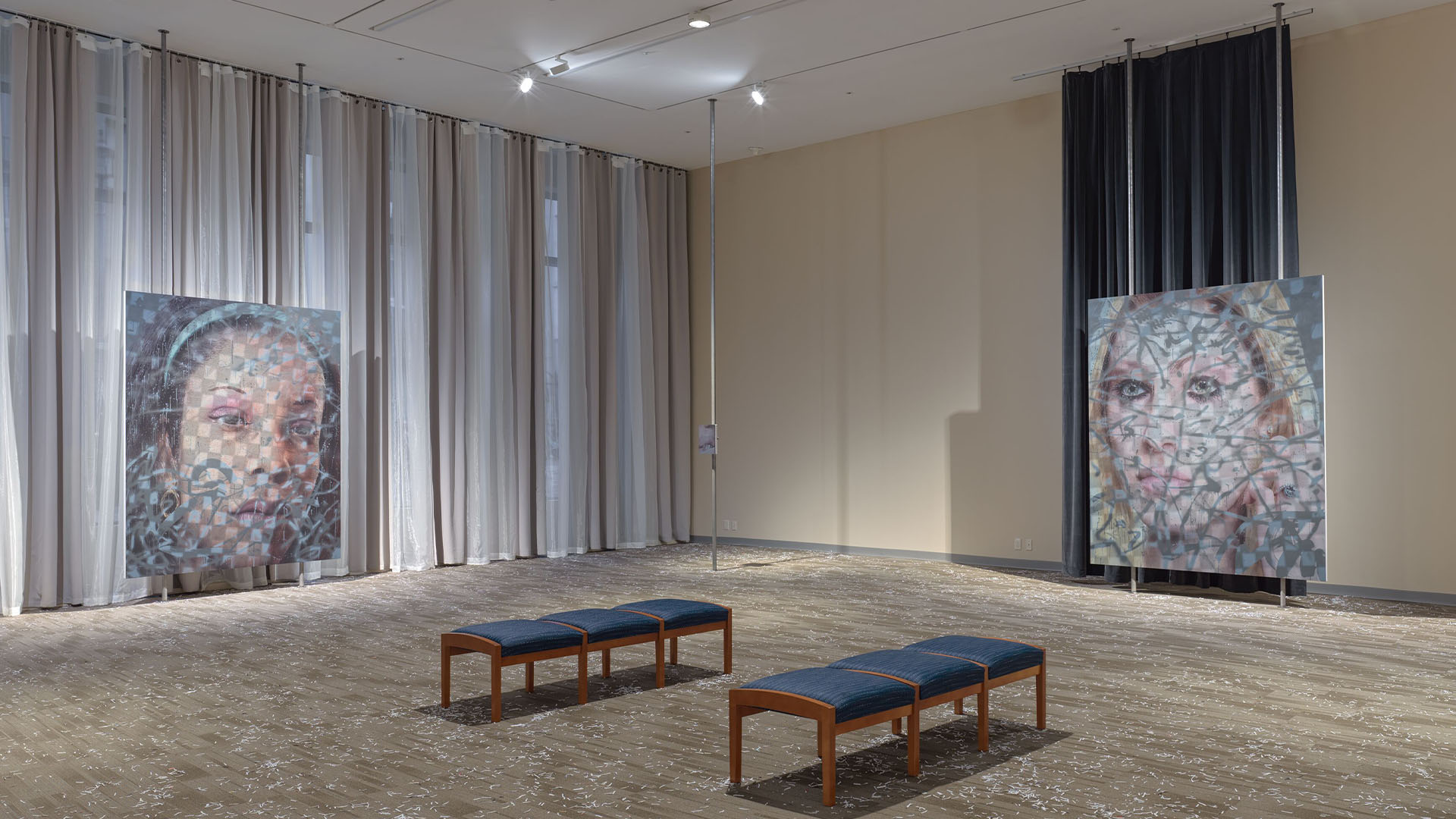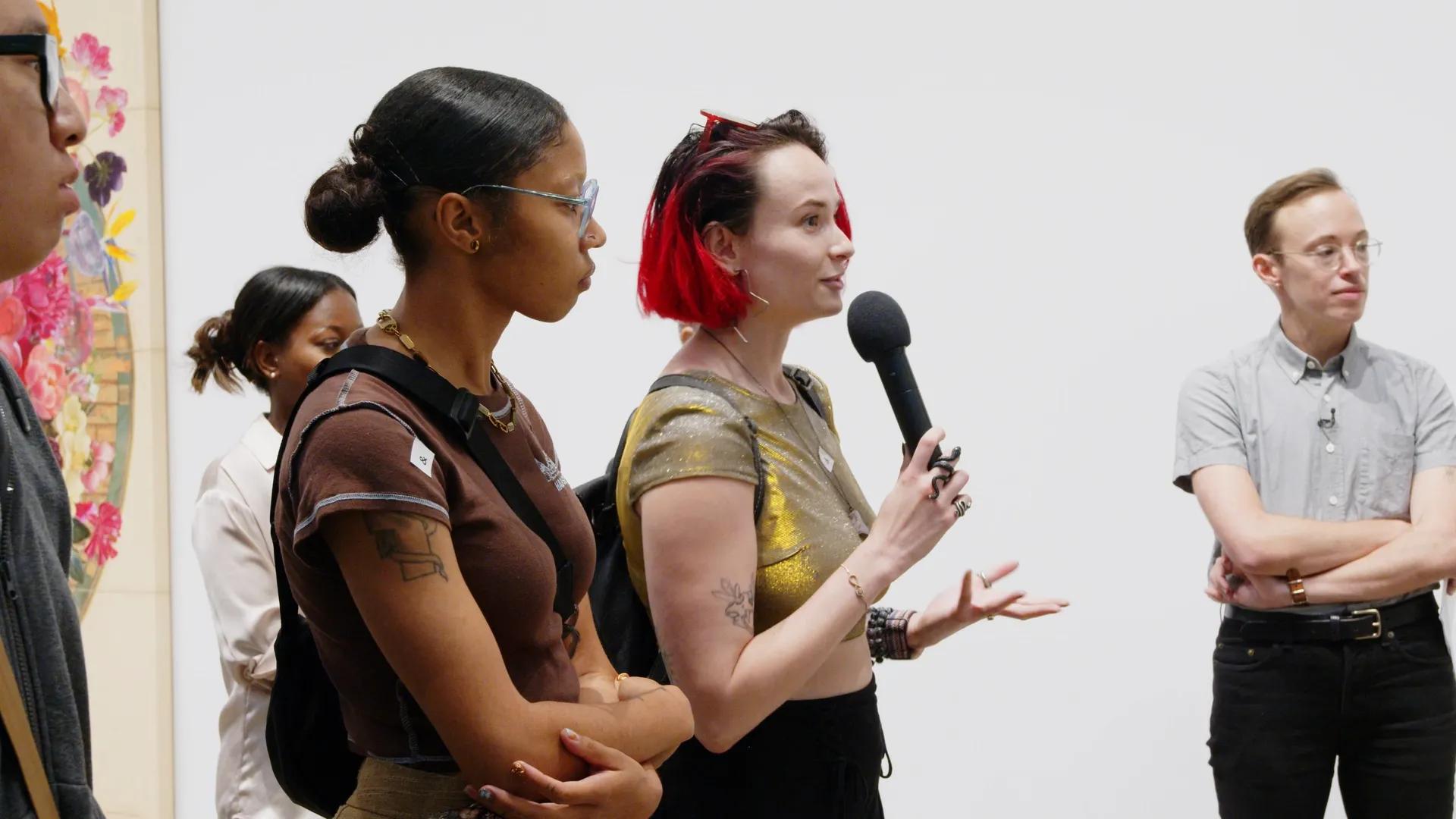
Avery Singer, 2023. Photo: Grant Delin
Exhibition Learning Notes: ‘Avery Singer. Free Fall’
This resource has been produced to accompany the exhibition ‘Avery Singer. Free Fall’ at Hauser & Wirth London from 10 October – 22 December 2023.
Click here to download a PDF version of this resource.
About Avery Singer
Born in 1987 in New York NY, Avery Singer has emerged as a powerful contemporary voice
whose work explores the possibilities in the convergence of painting and technology. Her
practice incorporates both autobiographical and fictional narratives, reflecting upon the art
world today and the wider sweep of art history that she has inherited as a painter. Singer studied
at the Städelschule, Frankfurt am Main, Germany in 2008 and received her B.F.A. from Cooper
Union, New York NY in 2010. Solo exhibitions of her work have been shown in the US (ICRA
Miami FL, 2023 and Hauser & Wirth New York, 2021) and Europe (Museum Ludwig, Cologne,
Germany, 2019; Stedelijk Museum, Amsterdam, Netherlands, 2019; and Kunsthalle Zürich,
Switzerland, 2014).
How Does She Make Her Work?
Singer’s pioneering techniques question the ways in which images and their distribution in
our contemporary world are increasingly informed by new media and technologies. Singer’s
working process is highly technologically advanced, resulting in finished artwork that is
often characterized by atmospheric spaces conjuring the digital realm. Her use of industrial
automation and three-dimensional computer modeling, such as SketchUp, Blender and DAZ 3D,
underpins a complex process of layering and the distancing of the human hand from the creation
of the work itself.
For this exhibition, Singer has predominantly utilized the software program ‘Autodesk Maya’. Within the software program, and in collaboration with an animator, she creates—and effectively art-directs—her own digital universe occupied by characters or avatars that she ‘casts.’ The scenes that she builds are then printed onto the canvas, layers in between which Singer then hand-applies a liquid masking, further blurring and re-defining the traditional notion of a painterly gesture. The use of the airbrush has become a central part of her working method since graduation. The resulting paintings contrast clarity with ambiguity, past with future, and geometric precision with intuitively generated forms, digital and analogue.

Installation view. ‘Avery Singer. Free Fall,’ Hauser & Wirth London, 2023 © Avery Singer. Photo: Alex Delfanne
What Does the Exhibition Look Like?
‘Free Fall’ is displayed across both spaces of the Savile Row gallery in London. The installation, which is part stage-set and part minimalist sculpture, brings the visitor on a journey through Singer’s personal experience and memories of the traumatic events of September 11, 2001. The artist has created an architecturally immersive environment based on her recollections of the interiors of the World Trade Center offices; spaces she knew well as her mother worked in both buildings until 2000. The installation deliberately echoes the iconic 18 inch slit windows that were such a characteristic feature of the Twin Towers, (designed by architect Minoru Yamasaki, 1912-86) to fend off sensations of vertigo by those working in the buildings. Integral to the space is the installation of a series of new paintings, each in their own way becoming ‘monuments’ of memory for the artist, a way for Singer to memorialize her own experiences of that infamous day.
Rather than hanging on the gallery walls, the paintings are mounted on industrial style steel poles which give the appearance of the works being suspended in space. This mode of display was originally developed for Singer’s solo show at Kunsthalle Zurich, Switzerland in 2014 and assists the artist to detach herself from the traditional ‘white cube’ aesthetic and draws attention to the essence of her creations—they being acrylic on stretched canvas—enabling the viewer to walk fully in the round to see all sides of the painting.
Notable subject matter within the new paintings are the works referencing what became known as the ‘famous’ faces of 9/11 including Marcy Borders and Rachel Uchitel; individuals suddenly catapulted to global attention by the world’s media when their images were broadcast and printed on TV screens and newspapers as the fateful events unfolded. These second-hand media images became important to the artist.
‘The portraits, which I have titled deepfakes, are mostly based around photographs I have gathered of the subjects. They are not manipulated using AI, but I have added details (such as makeup, jewellery, dust) that cannot be found in any of the original photos’.—Avery Singer
This second-hand archival material is complemented by Singer’s direct first-hand personal recollections as someone who lived a few streets away from what became known as ‘Ground Zero.’
In addition, with the themes of the exhibition, Singer has created a supplementary architectural intervention. The entrance of the South Gallery has been transformed into an approximation of the Borders bookshop located in the World Trade Center. Singer spent a lot of her adolescent years in this bookshop, and the genres and selection of book titles were deliberately chosen based on her time spent in Borders. The books are specifically from the early 2000s and are available for purchase.
What Influences Singer and Her Work?
Singer initially studied and experimented with sculpture, film and conceptual art, but increasingly moved into the domain of painting. An early influence on her thoughts and work was the painter Albert Oehlen (b. 1954, Krefeld, Germany). Oehlen’s practice is characterized by a mixture of abstraction and figuration, but importantly for Singer’s development, he also utilized computer aided programs, inkjet printers and references to pixelated computer screens in the creation of his work. Other important influences include Wade Guyton (b. 1972, Hammond IN) and his digital paintings produced with inkjet technology.

Installation view. ‘Avery Singer. Free Fall,’ Hauser & Wirth London, 2023 © Avery Singer. Photo: Alex Delfanne

Installation view. ‘Avery Singer. Free Fall’, Hauser & Wirth London, 2023 © Avery Singer. Photo: Alex Delfanne
Glossary
Deepfakes
The use of digital technologies to manipulate images and videos in order to create an artificial version of the original source material.
Functional
Having a special activity, purpose or task.
Ground Zero
A term given to the area of ground directly below the Word Trade Center towers after the September 11 attacks.
Historic/Historical Memory
A term usually applied to a group, community or nation who ‘collectively’ remember important events of major importance to them.
Industrial Automation
The specific use of software and robots to carry out tasks usually done by the human hand.
Installation Art
Installation art, also called ‘environments’ emerged as an immersive art form in the mid-20th Century. This type of art invites the public to step into spaces that are completely taken over by the artist’s creation and thereby ensure a more rounded interaction between viewer and art form.
Minimalist Sculpture
Minimalism emerged as an art movement in the late 1950s in the US. Its defining characteristics are the reduction of art forms to their basic structure or geometry and the use of factory production methods.
New Media
Modes of online digital communication and creation via computers, smartphones and tablets. Contrast with print media, TV and radio which is referred to as ‘old media.’
White Cube Aesthetic
An interior design style utilized by art galleries from the early 20th Century in which art was hung on white walls with specific use of spotlighting.

Installation view. ‘Avery Singer. Free Fall,’ Hauser & Wirth London, 2023 © Avery Singer. Photo: Alex Delfanne
Discussion Points
For this exhibition, Singer has drawn on her own personal memories and made them
‘physical’ through installation and paintings. Consider other artists (both contemporary and
historic) who have worked with the concept of ‘historical memory’. In what ways has the use
of memory inspired their practice and how does this manifest in their creations?
The reporting of 9/11 took place at a time before the current prevalence of social media. Facebook was launched in 2004, Twitter in 2006 and Instagram in 2010. The transformation of image culture between 2001 and today is a topic that interests Singer and other artists. In what ways might social media and other digital technologies impact on how artists conceive of and create artwork?
‘I begin on the computer, sketching or downloading things’. A central part of Singer’s artistic practice is her creation of computer-generated environments and characters on programs such as Autodesk Maya and regular use of airbrush techniques, as well as manual, to apply color to surfaces. How might these more digitised approaches affect the tone, mood and composition of a painting in contrast to more traditional techniques?
What memory would you transform into physical form? Would you create it in painting, sculpture, installation or some other medium. Would it be a personal or collective memory?
Supplementary Research
Print
Video
Resources
1 / 8









